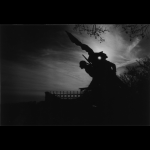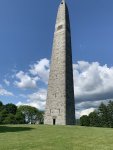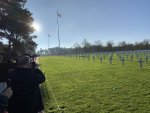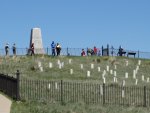I have three. In chronological order of the battle:
Gettysburg. Especially if you're familiar with the battle, it's incredibly moving to walk the grounds. For an Alabama guy, walking from the far right flank of the Confederate lines up to the peak of Little Round Top, and thinking about what happened there is humbling.
Also, the National Park Service guides are incredibly knowledgeable. Not cheap to hire, but well worth the money. Was $80 last time I was there in 2005.
If you do that, do some research and have some specific sites you want to see and specific well-thought-out questions. You don't want to waste access to this kind of expertise.
I took this picture of the North Carolina Monument. It was shot on B&W film, and the original won a prize from the Civil War Preservation Trust. This is a digital scan and some of the details aren't as prominent as in the wet-darkroom print.
 The Somme.
The Somme. This is a WW1 battle that took place in France about 100 miles NE of Paris, before the US got involved. Fought on the Allied side mainly by the Brits, Aussies, New Zealanders and Canadians. French as well. Lasted for just under 5 months along a long front (20 - 25 miles? I'm not sure). For the Commonwealth visitors, it's kind of a pilgrimage.
Mind-numbing casualties: Allied including French were over 600,000, of which about 140,000 were killed. German casualties totaled somewhere between 500,000 and 600,000, of which about 164,000 were killed.
In total, between 1,100,000 and 1,200,000, with over 300,000 killed. In 140 days.
That's an average of over 8,000 total casualties, of which over 2,000 were killed every day for 140 days.
As with a lot of WW1 battles, it's hard to say who won. The battleground is still relatively rural, and over 100 years later the ground is still throwing up what the local farmers call, "the iron harvest." We were on a day-trip tour out of Paris and drove by farmhouses with spent shells and other battlefield detritus piled up like cordwood.
Even today, every so often someone gets hurt or killed accidentally triggering previously unexploded ordnance. Parts of the trench lines are still off limits to tourists.
Here's a picture of the monument at Theipval, which was part of the larger Somme battle.

The thing is huge. I chose this picture because it conveys the scale....those small dots you see just above the first horizontal white concrete line are people.
It was significant to me because there are almost 80,000 names inscribed (therefore the size). They are the names of the missing from the Battle of the Somme. Just the missing.
No wounded. No identified dead. No captured. Just. The. Missing. In all likelihood virtually all of them were blown to bits so small that they couldn't be identified as even a body.
Normandy. That one's over 50 miles from Utah Beach on the western end to Sword Beach and Pegasus Bridge on the far eastern flank. Every American should see the cemetery overlooking Omaha Beach. One underpublicized part of that cemetery is a Wall of the Missing that is sobering.
I would highly recommend a guided tour. We used Battlebus and were quite satisfied. I don't know if they're still in operation, but there are several similar outfits and I'm sure they're good as well.
The organization and expertise of a professional helps to sew together all the sites you already know by name. Pointe du Hoc, St. Mere Eglise, Omaha Beach. And you don't truly understand the hedgerow country (a/k/a "the Bocage") until you see it.
If you go, try to be sure a little church in a village called Angoville au Plain is on the itinerary. The story of two American medics and the service they rendered there is absolutely inspiring. If you don't shed a tear, you don't have a heart.











